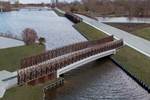University of Sheffield researchers to drive structural health monitoring in U.K. infrastructure
The £7.7 million program, ROSEHIPS, anticipates exploitation of machine learning, sensing and digital twin technology for automated health monitoring in infrastructure, such as bridges, telecoms masts and wind turbines.
Share
Read Next

Photo Credit: University of Sheffield
A collaborative team of researchers, led by the University of Sheffield (U.K.), has been awarded a £7.7 million program grant from the Engineering and Physical Sciences Research Council (EPSRC). The ROSEHIPS (Revolutionising Operational Safety and Economy for High-value Infrastructure using Population-based SHM) project will aim to solve the infrastructure asset management problem in the U.K. for maintaining the region’s buildings and structures, such as bridges and transport networks, via new research to automate health monitoring.
According to researchers, considering bridges, inspection is usually carried out visually by human experts. Resources are stretched, so inspections cannot be carried out as often as desired, repairs aren’t made quickly and opportunities are missed to make cost-effective decisions on maintenance and improvement. In a few extreme cases structural failure can result in fatalities. Currently, in the U.K., a backlog of maintenance work, identified in 2019, will cost £6.7 billion.
The offshore wind (OW) sector is another area for concern. OW has driven down energy costs and increased power output, pioneering a global change to clean energy. The U.K. provides almost one-third of the region’s annual electricity demand. The drive for turbines in deeper water demands new ways of asset management, controlling and limiting operation/maintenance lifetime costs. As turbines increase in numbers, size and capacity, these issues become even more important.
With these challenges in mind, researchers anticipate economically provided diagnoses by permanently installed sensors instead of expensive scheduled inspections, collecting structural data continuously and interpreting it via computer algorithms.
The team in Sheffield will work with partner institutions, the University of Cambridge (U.K.), Queen’s University Belfast (Ireland) and the University of Exeter (U.K.), combining sensor development, machine learning and civil engineering expertise, as well as with key industry partners, including Northern Ireland Department for Infrastructure, Translink (Winchester), Arqiva (Westminster, British Columbia), Cellnex (U.K.) and Siemens Gamesa (Hamburg, Germany).
“Population-Based Structural Health Monitoring (PBSHM) is a game-changing idea, emerging in the U.K. very recently,” Professor Keith Worden, from the University of Sheffield’s Department of Mechanical Engineering, notes. “It has the potential to overcome current technological barriers and transform our ability to automatically infer the condition of a structure, or a network of structures, from sensor data.”
The EPSRC project will extend and exploit PBSHM, developing machine learning, sensing and digital twin technology for automated inference of health for structures in operation now, and drive new standards for safer, greener structures in future.
The work will be underpinned by experiments using facilities such as the Structural Dynamics Laboratory for Verification and Validation (LVV) at the University of Sheffield to monitor the dynamic response and “health” of structures, such as traffic loading, at full scale or near full scale.
Related Content
-
CirculinQ: Glass fiber, recycled plastic turn paving into climate solutions
Durable, modular paving system from recycled composite filters, collects, infiltrates stormwater to reduce flooding and recharge local aquifers.
-
Swedish parking garage to incorporate decommissioned wind blades
Architect Jonas Lloyd is working with Vattenfall to design the multistory building with a wind blade façade, targeting eco-friendly buildings and creative ways to remove blades from landfills.
-
SGL Carbon carbon fiber enables German road bridge milestone
A 64-meter road bridge installed with carbon fiber reinforcement is said to feature a first in modern European bridge construction, in addition to reducing construction costs and CO2 emissions.















